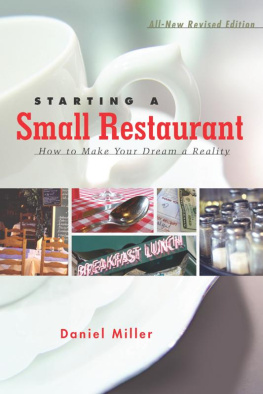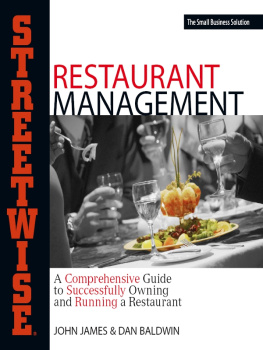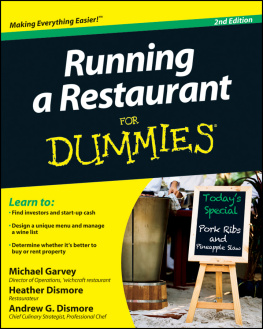The Harvard Common Press
535 Albany Street
Boston, Massachusetts 02118
www.harvardcommonpress.com
Copyright 1978, 1983, 2006 by The Harvard Common Press, Inc.
Illustration copyright 2006 by Paul Hoffman
All rights reserved. No part of this publication may be reproduced or
transmitted in any form or by any means, electronic or mechanical,
including photocopying, recording, or any information storage or
retrieval system, without permission in writing from the publisher.
Printed in the United States of America
Printed on acid-free paper
Library of Congress Cataloging-in-Publication Data
Miller, Daniel, 1932
Starting a small restaurant : how to make your dream a reality /
Daniel Miller.Rev. ed.
p. cm.
Includes index.
ISBN 1-55832-286-8 (hardcover : alk. paper)ISBN 1-55832-287-6
(pbk. : alk. paper)
1. Restaurant management. I. Title.
TX911.3.M27M54 2006
647.95'068dc22
2005020980
ISBN: 978-1-55832-286-8 (hardcover); 978-1-55832-287-5 (paperback)
Special bulk-order discounts are available on this and other Harvard
Common Press books. Companies and organizations may purchase books
for premiums or resale, or may arrange a custom edition, by contacting
the Marketing Director at the address above.
Cover design by Night & Day Design
Interior design by rlf design
10 9 8 7 6 5 4 3
To Shirley,
who has something special
from start to finish
Acknowledgments
This book could never have been if not for Shirley; Hilda Steele; Sheree; Abe and Ruth; Becky, Scott, and Mike; Andy and Jack Herrington; Jim Harris; Ken Kelly; Del Stanton; David Megibow; Brian and Sylvia Hume; Mabel Souza; Warren Leopold; Karen Gunther Theisz; Wilfred Lyons; Paul and Louise Squibb; Bob Doerr; Warren Talcott; Robert May, R.N.; Leslie; Ed and Kathleen; the 1971 San Fernando earthquake; Cambria, California, and a cast of thousands. But they didn't write it.
Also, additional thanks go to Jim and Karen Clarke, Joanne and Ross Currie, Eduardo Faubert, Edward Miller and Teresa Parker, Scott Miller, Eve and Tom Neuhaus, Keith Pellemeier, and Barbara Rubin for their warm hospitality, inspiration, and willingness to share their knowledge and experiences.
Finally, this revision reflects the editorial acumen of Pam Hoenig. Her improvements to the way I have expressed my ideas are invaluable, and for that I am very grateful.
Introduction
Have you tried a local, family-run restaurant recently? If you enjoyed it, compare it with what is described in this book. But if you found the place unsatisfactory, perhaps you can discover in these pages examples of what should have been done. If so, I urge you to strike a blow for restaurant customers everywhere by returning to the place to give it another chance. Take this book with you. If the restaurant has not improved, leave the book with the owner when you send back your uneaten meal. Then go home, instead of to another restaurant. Have a glass of wine and relax, and you'll feel better about the experience. Then resolve to open your own restaurantor to buy the place you just visited and improve it.
I have a theory about small restaurants and their unique role in today's stressful American society. They provide the public with one of the last vestiges of true enterprise and inventiveness in the current economic corporate concentration camp mentality. A small restaurant is one of the few places where the distraught parents of small children can regain their sanity and feelings of romance, where the weary traveler can feel truly at home, where a family can enjoy each other's company but not have to do the dishes, and where the owner's hard work and love of excellence show. Once the public discovers one of these good small restaurants, it really is appreciative and supportive. The place may eventually change, expand beyond control, go out of business, or fail to maintain qualitybut the customer always retains the choice of whether to patronize it. What matters in the long run is that such places can continue to spring up, like good mushrooms.
This book is for anyone who has thought about opening a small restaurant, or who has a friend who wants to do so. It is my purpose here to try to make it a little less scary for people without professional restaurant experience to be good mushrooms. Like the lowly mushroom, the small restaurant, if prepared properly, can overcome even an inauspicious beginning and add a unique and distinctive flavor to life.
Introduction to the New Edition
My experiences as a founder of the Grey Fox Inn, a small restaurant in Cambria, California, were instrumental in the creation of this book. At the time of the restaurant's founding, in the mid 1970s, no such book existed. My co-founders and I learned everything we needed to know about dining room practice, establishing relationships with suppliers, and other important aspects of the restaurant business through the guidance of a few experienced local workers and advisors. Everyone involved in the business has a stake in the success of a small fine restaurant, so they are generous with their help and advice.
The Grey Fox Inn's success rested primarily on the genius of one of the owners, who was also the chef. Her sense of style and personality infused every aspect of the operation. The relationships described in this book were experienced in real life and benefited from the loyalty and respect that the entire staff bore for the chef. Although the Grey Fox Inn no longer exists, the building it occupied remains in use to this day as a highly popular restaurant venue.
In the three decades since I first wrote this book, Americans have learned much about what is good to eat and where to find it. You are probably someone who appreciates locally baked bread and rolls and freshly prepared vegetables, fruit, fish, and fowl, combined stylishly for a meal. You may also want your meat to be raised humanely without harmful substances. By attending one of the many culinary arts training academies now operating, you may have prepared for a career in food service. Thirty years ago, an amateur without formal training stood a fair chance of success. My objective then was to encourage those with the requisite artistry and culinary sense to fulfill their dreams. This edition recognizes that if you have more formal training, in both food selection and preparation, as well as in business operations, you will have a greater chance for success than the amateur cook. I believe that today's sophisticated diners and the demands of seven days per week operation require that aspiring restaurateurs obtain formal training to ensure consistent quality. The enduring aim of this book is to encourage you to focus your talents and sensibilities toward owning and successfully operating a smaller restaurant rather than one run by a large corporate chain.
Fortunately, much has remained unchanged in the intervening years. Those values I praised in the original Introduction remain foremost in the smaller food service establishment, whether run by a family or partners. Although there has been a proliferation of restaurants of all sorts, the increase has resulted from a major shift in the typical workday and spending choices of patrons. People appreciate better, fresher food, but they have less time to prepare it at home. The stress in American family life, especially for those who work in the corporate business world, has taken its toll on those who used to prepare meals at home. Some have come to rely on so-called fast food. Your future customers appreciate "slow food" when they dine out, but they will also respond enthusiastically to your fast lunch service if your place serves good stuff. The prepared food counters at markets are their other source of better meals during their event-filled daily lives.
Next page












